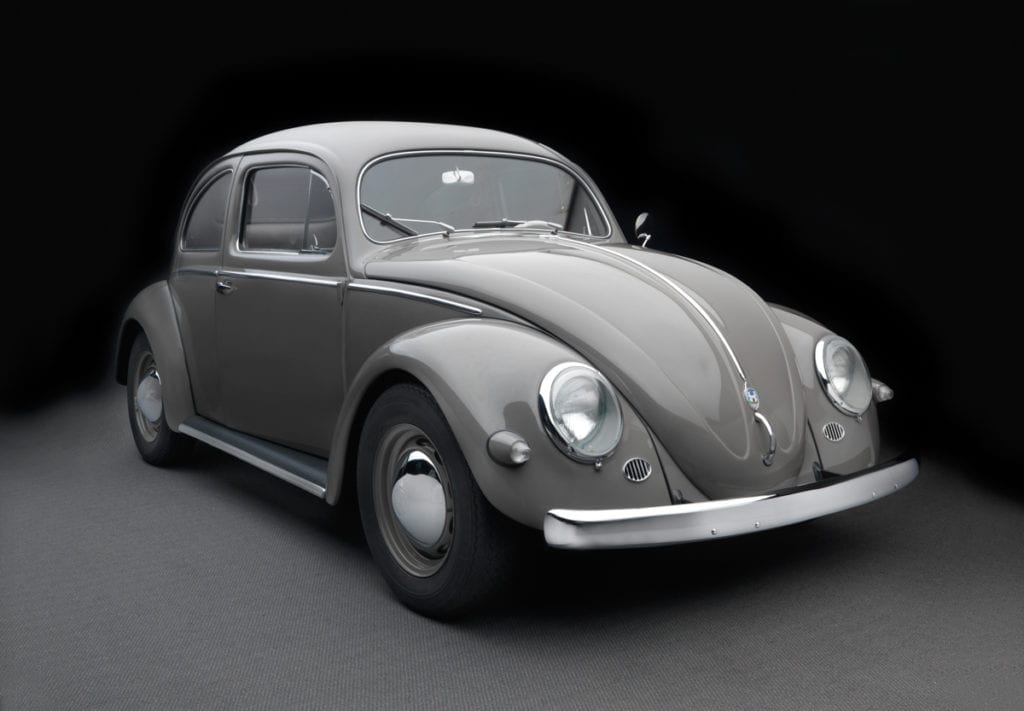The 1956 Volkswagen Beetle

Quietly wandering through the Miles Collier Collections at Revs Institute you come across a 1965 Ferrari 250 LM. A 1914 Rolls-Royce Silver Ghost. Dan Gurney’s 1967 Spa-winning Eagle F1 car. A 1909 Ford Model T. A 1956 Volkswagen Beetle.
Hang on, what is that last one doing on the museum floor?
It should come as no surprise, given the collections’ purpose, that this is no ordinary Beetle.
Inside the soul of most dedicated automobile enthusiasts rests a little niche for a hot rodder. That would include Miles Collier. It was about 35 years ago that he had the idea of creating a clone VW Beetle visually identical from the outside, but very much a hot rod underneath.
“It was one of those flights of fancy,” he explained. “A hot VW seemed like a great thing, but by my rules of engagement it had to look bone stock.”

Where better to start and create such an automobile than California? And where better there than the SoCal shop of Culver City-based Dick Troutman. Together with Dick Barnes, Troutman had created such landmark racers as the Troutman-Barnes Special, the Scarabs, the first Chaparral and the Ford Mustang concept car.
“I was working with Dick Troutman back in the day,” Collier added, “so it all seemed inevitable.”
Or an inevitable as a hand-made all-aluminum Porsche-powered Volkswagen Beetle could be.
What Troutman started decades ago remains a work in progress, but let’s begin nearly four decades ago with the pan and framework of a stock Beetle that the craftsman had to prep for new body panels. You can look at the images with this story and swear that bodywork is just as it came off the production line. But it isn’t. While the roof and inner structure of the special Beetle are steel, every other square inch of exterior metal you see is aluminum as hand-fashioned by Troutman…fenders, door skins, running boards plus the front and rear lids. Even the bumpers are aluminum, flashed with copper and then chromed. Maybe the bumpers are two elements you would not want to be malleable, but it was all part of the weight-reduction plan.

The seating in the VW gives a tiny hint that this 1956 Volkswagen is not what it appears to be. The seats are not stock, but they were inspired by the period. Replica Porsche Speedster seats were installed to give the sort of back and side support needed for the car’s modern performance.
At first look, the dashboard appears to be factory fresh, yet it isn’t. The 80-mph speedometer face is correct, but the instrument is, in fact, an 8000-rpm tachometer. In a discreet area on the lower dash nearly invisible red LEDs monitor oil pressure and temperature. An alloy roll bar was added for both structural rigidity and safety…and for good reason.
That takes us under the aluminum engine cover in the VW and what happened after the body was completed and the car was shipped to CH Motorcars in Naples, now home of the Revs Institute. Here it received its heart.
“The idea was to dump a bunch of Porsche technology into it,” Collier continued, “so GT brakes and a flat-fan Spyder motor seemed good. An early 911 tranny, rear torsion tube and trailing arm suspension were designed into the build to avoid the swing axle rear suspension and, relative to the engine, the less-than-robust Beetle gearbox.”
Very sharp eyes might notice the wheels look somewhat different than stock Beetle wheels of the era. That’s because they had their offset changed so they would fit properly within the fender and inner fender. They happen to be fitted with period-correct Pirelli CN36 Cinturatos the tire firm is reproducing today.

Inside the wheels are alloy drum brakes from a Porsche 356GT. They came off the parts shelf at CH Motorcars to make the VW unique, to fit within the Porsche family and get the hopped-up VW stopped. They are unaltered so they could go back on the shelf should further modifications to the VW take place. Given the work-in-progress feeling about the VW, that could happen someday.
From the start, the aluminum VW was quick, thanks to the same sort of 1679-cc, 183-hp 4-cam, flat-4 with its roller bearing crankshaft that powers the Elva MKVII Porsche race car in the collection. Being a hot rod, however, always leaves the door open to change. This happened not long ago.

“Recently we concluded the 547/5 flat fan-4 was too peaky for road use and so we went to a Jake Raby-built Porsche 2.6-liter type 4,” Collier said. “That engine’s 210 hp and oodles of torque(just shy of 200 lb-ft) make that a great improvement.”
Mated to a Porsche 901 transaxle, this isn’t a race engine, but built for the road and pump gasoline.
“It has turned into an unbelievably great handling and blooming fast bit of kit. It will be out and about a lot,” Collier said.
While the aluminum V-Dub isn’t the sort of car one takes to a drag strip, we can ballpark its performance. The 1782-lb Beetle has a horsepower-to-weight ratio of 8.5 lbs per hp. It’s near impossible to match a more modern car’s specs to the VW’s given gearing, tire sizes, torque curves, etc. but one can interpolate. Check back to the mid-1960s and you’ll find Beetles needing 20 seconds or more to get to 60 mph. With a tail wind. Near as we can figure, this VW hot rod as currently configured could get to 60 mph in right around 5.0 seconds.

We do know the lightweight VW’s top speed. Gunnar Jeannette has been clocked at more than 120 mph during a session in which the car was track tested. Terminal Beetle speed in the day? About 77 mph.
Why does one suspect the Collier Collections’ hot rod VW would bring a smile to the face of its creator, Ferdinand Porsche?